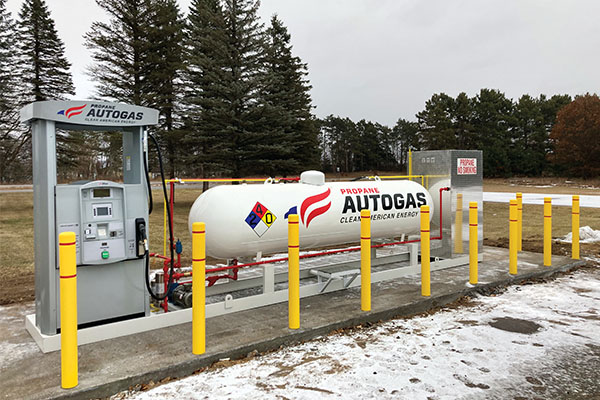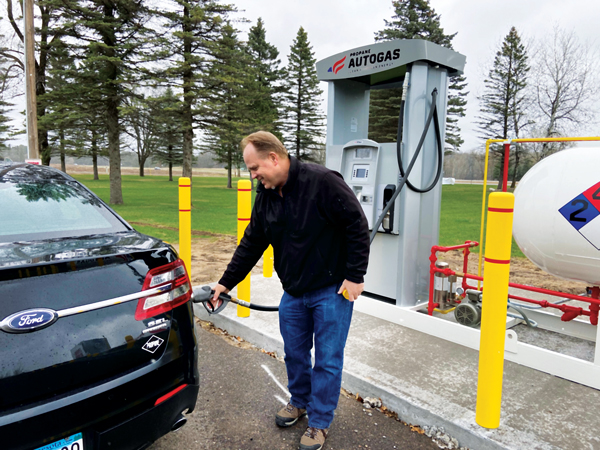Dual-use propane dispenser promotes safety, market growth
In early 2020, the Minnesota Propane Association (MPA) and the Minnesota Propane Education Promotion and Safety Council (MNPEPSC) began to collaborate on a project that would not only help educate the propane industry but also the propane-using public.

The autogas and cylinder-filling dispenser will be used for training, demonstrations and refueling. Photo courtesy of LPG & NH3 Supply Inc.
That collaboration has now become a propane dispensing reality.
The project – a dual-use autogas and cylinder-filling dispenser – will help train cylinder-filling industry employees and the autogas-using public while also accommodating the public’s refueling of autogas vehicles.
To achieve these goals, the MPA, which moved last year into a new 11,000-sq.-ft. office and training facility on a 5-acre property along Highway 169 in Zimmerman, and the MNPEPSC partnered with industry members to plan the installation of the propane dispensing system. Highway 169 is a major north-south route from the metropolitan areas to central Minnesota.
“Due to its location, more than 30,000 vehicles drive by the new facility each day, on average,” says Dave Wager, executive director of the MPA. “As a result, it’s provided us an opportunity to extensively promote autogas to thousands of people.”
Autogas promotion
After conversations among the MPA, the MNPEPSC and industry members, project leaders determined the dispenser would be utilized primarily for promotional and training purposes.

The facility promotes autogas refueling. (Photo courtesy of Minnesota Propane Association)
Aside from promoting autogas to thousands of commuters every day, the dispenser, with a 1,000-gallon tank, will also provide a convenient refueling point for school buses that travel from the northern parts of Minnesota.
Serving as an example for marketers regarding the equipment that’s required to meet and exceed customers’ expectations, while also complying with applicable and appropriate requirements and standards, the dispenser will also be utilized to refuel any type of autogas vehicle, along with small cylinders that are used to fuel propane mowers.
The Gilbarco Encore 700 S dispenser will be utilized several times a week to fuel the MPA’s two autogas vehicles. Initially, the MPA will dispense about 2,500 gallons annually; however, its usage will continue to increase as more people try autogas. To ensure safety and security, the dispenser is installed on a concrete base with crash-protection bollards.
The MPA funded the project through the Propane Education & Research Council’s state rebate program. About 80 percent of the funding applied to the dispenser, its concrete base and crash-protection bollards, along with excavation, labor and transportation. Funding expenditures were also used for communications and electrical work.
“During October and November, we completed the site preparations, installed the crash-protection bollards, poured the concrete slab and roughed in the communications and electrical,” says Jeff Head, sales and marketing manager at LPG & NH3 Supply Inc., the developer on the project.
“Simultaneously, the dispenser’s heavy-duty steel frame was fabricated, welded and painted with an automotive-grade urethane, which provides a long-lasting, durable finish.”
After a subcontractor returned the painted steel frame to LPG & NH3 Supply, the company completed the remainder of the assembly – including cabinets, filtration system, pump, motor, piping, hoses, nozzles and tank.
LPG & NH3 Supply transported the dispenser to the MPA’s facility in late December.
“The dispenser is now operational,” Wager explains. “We have some landscaping yet to do, but other than that, it is complete.”
Training for the future
With the dispensing system, the MPA and MNPEPSC will be able to train individuals within the propane industry on the procedures for the inspection and refilling of cylinders.
“Classroom and online training are good, especially when in-person training is almost nonexistent, as it’s been the last few months. But hands-on training is preferred by our members and by the staff taking the training,” Wager stresses. “By being able to show people how to inspect and requalify a cylinder, along with proper filling techniques, they’ll be better trained and more confident.”
Additionally, public individuals who fill cylinders, particularly at campgrounds, lawn care companies and service stations, will now be able to receive quality, hands-on training with regard to safety and proper procedures. In fact, by being able to demonstrate how to properly inspect and fill cylinders in a safe, easy manner, the MPA and MNPEPSC will help ensure proper practices are being maintained.
“Along with the dispenser, we’re also planning on providing lawn mower demonstrations,” Wager adds. “Not to mention, we’re also considering demonstrating exchange cabinets to equipment operators.”
The MPA and MNPEPSC will also be able to advance propane safety, as the process of filling cylinders will be demonstrated properly. For example, propane users will learn how to utilize a pump. They’ll also be able to inspect tanks for improper O-rings, overdue inspection dates and overall damage, as the practices they learn will not only enhance safety but also eliminate downtime.
Effective demonstration
As bus companies and fleets continue to increase their usage of propane for engine fuel, the MPA and MNPEPSC are also striving to demonstrate – and provide – the best facility they can for autogas refueling.
“The goal is to have a system available for bus companies and fleets to use as they transition to autogas as well. It’s a chicken-and-egg thing,” Wager explains. “We want them to be able to start the transition before they need their own infrastructure.”
He continues, “Our goal is to not compete with our members, but to grow load so they can install their own equipment for bus companies and fleets. We want to keep our usage to a beginner’s level and provide the increased gallons to our members.”
Of equal importance, the MPA’s dispensing facility will be certified for public refueling and available 24/7 via credit card access. By showing the public that anyone with an autogas vehicle and a Euro nozzle can refuel at any time, the MPA will be able to demonstrate the ease and efficiency of refueling.
Any MPA member can also utilize the dispenser for demonstrations, as Wager believes it’s significant for the propane industry to showcase how easy the system is to install and use, as it can be placed virtually anywhere, all while requiring little outside infrastructure.
“The dispenser will show that an alternative fuel vehicle can be refueled in a matter of minutes,” Wager says. “And it will prove that a low cost, low carbon and American-produced energy source is available today.”
He adds, “The bottom line? This dispenser will bring the public – cars, fleet trucks, lawn mowers, pickups, school buses, you name it – to one location for demonstrations, education and training. It will be our industry’s showcase system.”
Dispensing details
Here are several notable features of the Minnesota Propane Association’s dual-use dispenser:
- Provides both autogas and cylinder-filling capability. Typically, customers purchase either a cylinder-filling dispenser or an autogas dispenser.
- Uses a variable frequency drive to essentially create three-phase power using single-phase power. It also conditions the power.
- Has an ATM-type user interface and is EMV-compliant, protecting personal information during credit card use. Available to the public 24/7/365.
- Incorporates a two-stage Donaldson filtration system. The carbon filter traps oily, waxy and heavy ends. The particulate filter limits particles from being passed to a vehicle. Both of these, together, reduce maintenance and extend the life expectancy of vehicle systems.
Source: LPG & NH3 Supply Inc.
















